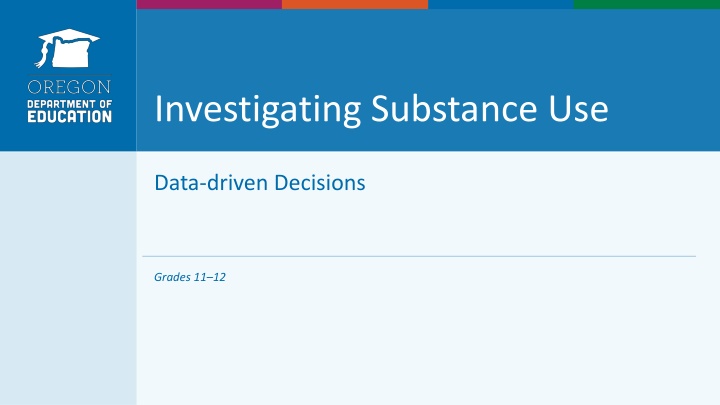
Analyzing Substance Use Data for Informed Decision-Making in Grades 11-12
Explore how high school students in grades 11-12 can utilize data on substance use to make informed choices, address social injustices, and analyze local trends. Discover essential questions, learning goals, and peer responses related to tobacco products, alcohol consumption, and prescription opioid use based on the Oregon Student Health Survey data.
Download Presentation

Please find below an Image/Link to download the presentation.
The content on the website is provided AS IS for your information and personal use only. It may not be sold, licensed, or shared on other websites without obtaining consent from the author. If you encounter any issues during the download, it is possible that the publisher has removed the file from their server.
You are allowed to download the files provided on this website for personal or commercial use, subject to the condition that they are used lawfully. All files are the property of their respective owners.
The content on the website is provided AS IS for your information and personal use only. It may not be sold, licensed, or shared on other websites without obtaining consent from the author.
E N D
Presentation Transcript
Investigating Substance Use Data-driven Decisions Grades 11 12
Essential Questions (1) How do statistics and facts about substance use and misuse inform my choices and actions in my community? How do I make informed choices and work to address social injustices after analyzing information? 2
Learning Goals I can analyze local data on substance use and misuse using a data dashboard or data tables. I can identify data trends within my community I can reflect on how evidence-based information can guide personal choices and community action. 3
How would your peers respond? (1) Select all of the tobacco products they used in the past month. Cigarettes Vaping product or other e-cigarettes Chewing tobacco, such as Skoal or Copenhagen Cigarillos or little cigars, such as Swisher Sweets Hookah or waterpipe Any other tobacco project None of these products 4
How would your peers respond? (2) How old were they when they had their first drink? They have never had a drink of alcohol other than a few sips 12 years old or younger 13 years old 14 years old 15 years old 16 years old 17 years old I am not sure 5
How would your peers respond? (3) During the past 30 days, did they use prescription opioid drugs such as Oxycontin, Percocet, Vicodin or Codeine without a doctor s orders or differently than how a doctor told them to use it? Yes No I am not sure I prefer not to answer 6
Essential Questions (2) How do statistics and facts about substance use and misuse inform my choices and actions in my community? How do I make informed choices and work to address social injustices after analyzing information? 10
Community Agreement Statistics are more than just numbers. There are people and stories behind the data. Take care of yourself and take care of our classroom community as we dig into the data. 11
Oregon Overdose Dashboard Go to https://oregoninjurydata.shinyapps.io/overdose/
Activity Instructions 1. Open the dashboard. 2. Use the scavenger hunt to get oriented. 3. Use the questions to get deeper into the data. What substances have the highest rate of misuse among teens? How have overdose rates changed over the last five years? What do you notice about your county? 4. What does the data tell you? Capture your questions. Capture your a-ha s. Find something that you would like to share with the class. 13
Connecting Data to Actions What can we do to promote personal, family and community well-being? Consider the role of education, policy, resources and access. How might you think about prevention and harm reduction? 14
Closing What data trend surprised you most? How does this data connect to your personal choices? What micro-step could you take to help your community address substance use and misuse? 15






















